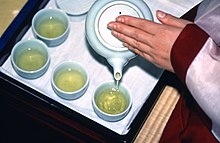Korean tea
| Traditional Korean tea | |

nokcha (green tea)
|
|
| Hangul | 전통차 |
|---|---|
| Hanja | |
| Revised Romanization | jeontongcha |
| McCune–Reischauer | chŏnt'ongch'a |
| IPA | [tɕʌn.tʰoŋ.tɕʰa] |
Traditional Korean tea, called traditional tea (Korean: 전통차) in Korea, is a drink made by infusing leaves, roots, flowers, fruits, grains, edible mushrooms and/or seaweed in water. Although tea is not as popular as coffee in South Korea (annual tea consumption is 0.16 kg (0.35 lb) per capita, compared to 3.9 kg (8.6 lb) for coffee), grain teas are served in many restaurants in place of plain water, and herbal and fruit teas are commonly served both hot and cold.
According to Record of Gaya, cited in Memorabilia of the Three Kingdoms, the legendary queen Heo Hwang-ok, a princess of the Ayodhya married to King Suro of Gaya, brought the tea plant (Camellia sinensis var. assamica) from India to Korea and planted it on Baegwolsan, a mountain in current Changwon. However, Labrador tea and fruit teas, such as magnolia berry tea and goji berry tea, were more common until the Samhan Era.
It is a widely held belief that the systematic planting of tea bushes began with the introduction of Chinese tea culture by Buddhist monks some centuries later. Some of the earliest Buddhist temples in Korea, Bulgapsa, Bulhoesa, and Hwaeomsa all claim to be the birthplace of Korean tea culture. The first import of Chinese tea products started during the reign of Queen Seondeok of Silla (631‒647), when two types of tea bricks, jeoncha (전차; 磚茶) and dancha (단차; 團茶), were imported from the Tang Empire. In 765, a Buddhist monk presented an offering to King Gyeongdeok and to Buddha. The small-leaved Chinese-type tea plant (Camellia sinensis var. sinensis) spread throughout the country in 828, when King Heungdeok received tea seeds from the Tang Empire and sent them to be planted on Jirisan. Tea was commonly offered to Buddha, as well as to the spirits of deceased ancestors.
...
Wikipedia
